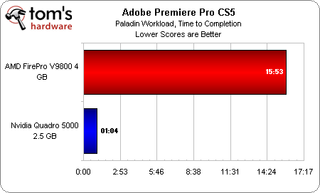AMD FirePro V9800 4 GB: Eyefinity Meets Professional Graphics
What's red, black, sports 4 GB of GDDR5, and has DisplayPort outputs all over? AMD's FirePro V9800, the company's ultra-high-end workstation card. We run it through a battery of SPECapc and real-world performance tests, then compare it to Quadro 5000.
Benchmark Results: Adobe CS5 Suite

Our standard Photoshop benchmark is optimized for threading, but it’s not built to test the few OpenGL-accelerated tasks Photoshop can execute. Thus, it’s hardly surprising to see both graphics cards turning back identical performance.

Our After Effects project doesn’t make extensive use of the Mercury Playback Engine. Nevertheless, Nvidia gets the job done just a little faster.

Our render job finishes faster on Nvidia’s Quadro 5000, but the Adobe Media Encoder task is, fundamentally, just as fast on both graphics cards. Again, this is an entry-level rendering job, though. What happens when we crank things up from weaksauce to hot sauce?

Paladin, directed by John Allardice, was distributed by Adobe during the CS5 launch to showcase what the software can do. It’s much more effects-heavy than our in-house benchmark, setting it up as a wonderful worst-case scenario for Hollywood-quality rendering jobs.
The impact of GPU-based acceleration here is phenomenal. Premiere Pro 5.0.2 added support for the Quadro 5000, but you don’t necessarily need one of the supported cards to accelerate the Mercury Playback Engine. Check out William Van Winkle’s story on Adobe CS5 for more on enabling hardware support with any CUDA-enabled GPU.
Stay on the Cutting Edge
Join the experts who read Tom's Hardware for the inside track on enthusiast PC tech news — and have for over 25 years. We'll send breaking news and in-depth reviews of CPUs, GPUs, AI, maker hardware and more straight to your inbox.
Current page: Benchmark Results: Adobe CS5 Suite
Prev Page Benchmark Results: SPEC Next Page Benchmark Results: Vue, Cinebench, MatchMover, And Blender-
Nvidia shines in the industrial/commercial/scientific market, with their driver team and CUDA/GPGPU tech. Too bad the V9800 fell short of expectations. Also, Nividia cards are obviously going to have better results in Adobe Mercury since both companies worked together on hardware optimization. AMD needs to be more aggressive in working together with software makers, (including games!) to have a stronger hold on both the CPU and GPU markets. Overall, a good read.Reply
-
reprotected It would actually make sense if they compared with the V8800 and the Quadro 6000. We also need a review of the Quadro 4000, 2000 and the 800, along with the lower Firepro 3D series.Reply -
reprotectedIt would actually make sense if they compared with the V8800 and the Quadro 6000. We also need a review of the Quadro 4000, 2000 and the 600, along with the lower Firepro 3D series.1. Definetly, a review of the "lower end" cards would be nice.Reply
2. Plus, it would be nice to see how well the SLi cards scale.
3. Also, with the updated (e)nVidia desktop cards (GF100 to GF110), will the Quadro ones see a revision too - if so, when? -
cangelini radiovan1. Definetly, a review of the "lower end" cards would be nice.2. Plus, it would be nice to see how well the SLi cards scale.3. Also, with the updated (e)nVidia desktop cards (GF100 to GF110), will the Quadro ones see a revision too - if so, when?Reply
Good question (3), I'll ask!
Cheers,
Chris -
Cwize1 This was a rather underwhelming test suit. I think the fundamental problem you have is that most of the tests you ran were CPU based.Reply
What most of these production apps use the GPU for is on the fly rendering. For example, sculpting in blender can tax the GPU quite nicely given enough vectors. Another good blender one would be playing back a super resolution baked fluid simulation in real time. For example, take the tom's hardware logo you had before, turn it into water and let the water fall onto a flat surface. Bake the simulation with a ridiculous resolution (as much as you can before blender crashes) and then play the simulation back in real time while watching 5 high definition videos at the same time. -
hell_storm2004 The FirePro has still the long way to go to catch up with the Quadro. I hope ATI makes good progress in the workstation models soon like they have come a long way in the desktop market.Reply -
eclecticfortune In this article's conclusion appeared this statement:Reply
"If you’re a creative professional working with Adobe’s CS5 suite, then the Quadro is hands-down a no-brainer."
Benchmarks indicate that the lower priced GTX 480 is a far better choice (cost effective)for those taking advantage of the Mercury Playback Engine running Premiere Pro CS5.
http://ppbm5.com/Benchmark5.html
At the top of this page, click on the "MPE Performance Chart" to get a comparison between the different Nvidia Cards with Premiere Pro CS5.
Most Popular


